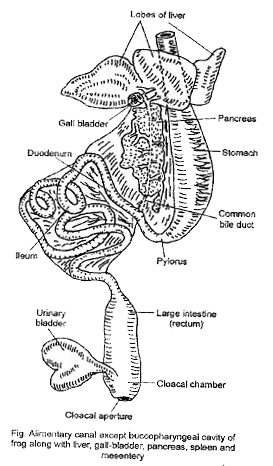Describe alimentary canal of frog.
Text Solution
Alimentary canal of frog. It is complete i.e. has at one end mouth and at second end anus for ingestion and egestion respectively: It has following parts :
I. Mouth
2. Buccopharyngeal cavity
3. Oesophagus
4. Stomach
5. Intestine
6. Cloaca
7. Cloacal aperture
I. Mouth. Mouth is a wide anteriormost opening leading to a spacious buccopharyngeal cavity. Mouth enables the frog to capture large prey. It is bounded by immovable upper jaw and movable lower jaw.
2. Buccopharyngeal cavity. It is so-called because the buccal cavity and pharynx have been merged into one cavity. Due to the absence of neck, it opens into oesophagus through gullet.
3. Oesophagus. It is a small passage which opens into stomach.
4. Stomach. It is thick walled, dilated, tubular, curved structure lying in the left side of the body cavity. The stomach is divisible into two parts :
(i) Cardiac stomach which is the anterior larger part present near the heart, the anterior end of which is connected with the oesophagus. The opening of the oesophagus into the cardiac stomach is guarded by a cardiac sphincter, a powerful ring of circular muscles, which prevents the backward flow of food.
(ii) Pyloric stomach is a posterior narrow tapering part, which is separated from: the duodenum by a muscular constriction, the pyloric constriction externally. It indicates the position of pyloric sphincter, which controls the entry of food into duodenum. The internal lining of the stomach wall is produced into longitudinal branching folds, which enable the extension of stomach when it receives the food from the oesophagus. The gastric glands are also present on these folds.
5. Intestine. It has two parts :
A. Small intestine
B. Large intestine
A. Small intestine. It is the longest part of the alimentary canal suspended by mesentery, and is divisible into duodenum and ileum.
(a) Duodenum. It is a thin walled narrow tube which bends forward parallel to the stomach to form a .U. shaped structure. Its internal lining is thrown into transverse folds. It receives the hepatopancreatic duct from the liver and pancreas. The duodenum passes into the ileum.

( b) lleum. It is also a thin walled, but longer narrow tube which is coiled in a haphazard manner in order to accommodate itself in a limiteil space.
The internal lining of the ileum is also thrown into a large numller of finger like branched projections known as villi which increase the absorptive surface area.
B. Large intestine or Rectum. The ileum leads into a broad, thin walled short but wider tube, known as rectum or large intestine, suspended by a mesentery, the meso-rectum. Posteriorly it opens into the cloaca through an aperture known as anus which is guarded by an anal sphincter. The rectum stores the faecal matter and water is absorbed by its wall.
7. Cloaca. It receives the rectum in both sexes, but in female frog, the cloaca also receives the ureters and oviducts, while in the male the urinogenital ducts are received in addition to the rectum.
The urinary bladder also opens into the cloaca.
8. Cloaca/ aperture. The cloaca opens out through a cloacal aperture, situated at the posterior most end of the abdomen.
|
Updated on:21/07/2023
Similar Questions
Describe the alimentary canal of man.
View SolutionDescribe the alimentary canal of an earthworm and its interactions with mankind.
View SolutionDescribe human alimentary canal . Draw a labelled diagram of human alimentary canal.
View SolutionAssertion : The alimentary canal of the frog is short
Reason : Frogs are carnivores.View SolutionAssertion : The alimentary canal of the frog is short
Reason : Frogs are carnivores.View SolutionLargest gland of alimentary canal of frog is
View SolutionName the various parts of alimentary canal in frog.
View SolutionName the various parts of alimentary canal in frog.
View SolutionDefine the Alimentary canal
View SolutionAlimentary canal of Ascaris is
View Solution

